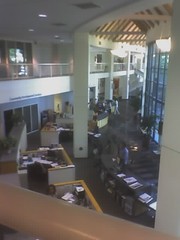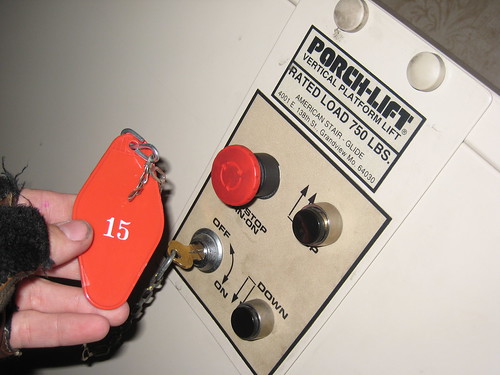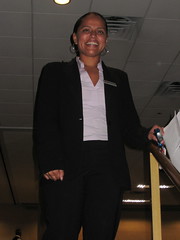My experiences with activism, and also my peripheral awareness of politically savvy friends, taught me some things that aren’t automatic knowledge. In this case, I would like a 4-way stop sign at an intersection near my house. I would also like curb cuts — sloping ramps from the sidewalks to the street — at the busy intersections along my street, between the grocery store and the many apartment buildings and the two schools. And incidentally… to my house.
If you saw me in the street with my 7 year old at 8:15 am this morning you would understand a little bit better. It is hard for me to find a place to cross the street. The curbs and driveways are steep. Some driveways I can go up and down, and some I can’t, especially if I’m tired and hurting. Meanwhile, my kid wants to walk next to me, but I won’t let him, so I’m trying to herd him by shouting, and keep us both caught up, and teach him traffic awareness and how to cross the street, but while I’m in the street and we are separated by parked cars. Giant Hummers and SUVs driven by people talking on cell phones fail to stop when they see me, even when they’re at stop signs, and they blow past me at 40 miles an hour while I’m out in the middle of the road going past parked cars with people getting in and out, parallel parking with vans full of kids. It’s a nightmare because the drivers are careless and distracted and ill-tempered and inconsiderate. Because we don’t have school buses in this district, everyone has to walk or has to drop off their kids on the way to work. The police circle the block, giving tickets to the worst offenders.
So, what to do? I need to be able to cross the street in my wheelchair! At an intersection! With my kid!
I looked up some addresses on the city web site and wrote a couple of emails months ago. When I realized that didn’t have any result, I figured I’d go in person to City Hall and ask questions. Procrastination ensued. I continued wheeling my wheelchair in the street whenever I needed to get groceries.
After three days of walking my son to and from school during periods of very heavy traffic, I lost patience with the situation. A few years ago, I watched my friend Elaine work the machinery of the city, and her position as president of the Moms’ Club, to get a stop sign at a busy intersection that was between her house and the local playground. It benefited everyone in the neighborhood. I saw her do very similar things to get shade structures and bathrooms in some of the local playgrounds! But if it were not for seeing her go through that political process, it wouldn’t have occurred to me to do what I’m doing now.

So! I went to City Hall. I asked at an information desk who I should talk to about sidewalks, ramps, and stop signs.
Step one. I explained briefly what I was looking for at the information desk. The information desk person told me to go to Planning.
Step two: The guy at the Planning desk told me to go to the Public Works building. I asked him more pressing questions, and he responded that maybe I could talk to someone in Engineering, but that would not help and the people responsible were in Public Works (across town.) Since those were the people I wrote to in the first place who didn’t respond and I didn’t trust his information and I didn’t want to pack up my wheelchair and drive across town and unpack myself into the wheelchair again, I told him I was going to go upstairs to the big sign I could see that said “City Manager” and “City Attorney” since I suspected there was some more direct path to action. He seemed mildly perturbed. I smiled with sharky politeness.
Step 3: On the way to the elevator, I told the information desk person #1 (nicely) that the person she had sent me to didn’t know what I should do next.
Step 4: Upstairs, an information desk or reception person for the City Manager seemed to know what I was talking about and what to do. She looked up some information online, and wrote down a name and phone number and email of Rich, the Traffic Engineer, and his assistant Peter, who were just downstairs next to the Planning desk I had gone to in Step 2.
Step 5: Someone came to talk with me at the Maps and something-or-other desk after I waited a few minutes. I gave my two-sentence summary of what I would like. She asked if I had an appointment to speak with Saber. I said I did not, but I would like to wait and speak with anyone who could explain the next steps in the process to me. She said things that indicated everyone was very busy and went away. I waited.
Step 6: An engineer, Brendan, came out to talk with me. We went over to a low desk that was pleasantly wheelchair accessible, with a large, lightweight computer monitor that swivelled around. I explained to Brendan, and showed him my map of the 3 blocks between the grocery store, my house, and the school. On it I circled the places I wished for curb cuts, and the intersection that I think needs a 4-way stop instead of a 2-way stop. I asked Brendan what I should do next to request these things from the city, through official channels.
(Here is where I would not have known there *was* a way to do this sort of thing, if not for the local Redwood City Moms’ Club and its email list, and my friend Elaine.)
(I would like to point out the many steps before this actually productive step; Expect delays, and uncertainty, and people who don’t know what to do next or who to refer you to; Don’t get mad at them, but keep patiently asking different people until you hit the good one who will say, “I don’t know, but let’s go find out.”)
Step 6, continued: Brendan listened intently to my explanation. He said that I should do separate requests for the stop sign — for which there was a known procedure — and for the curb cuts, which no one understands, which take longer, and which will cost a lot more.
Then, Brendan he explained what I should do and what would happen next. I should write a letter to the Senior Engineer, Saber. I gave a feral grin and whipped out my computer. There was wireless. I wrote the letter and showed it to Brendan across the desk. He said it looked okay. I cc-ed the letter to one of the school principals and to my housemates, the only people on my block whose email addresses I know offhand.
Then I took notes on paper for what he said next. Here is what will happen and what I should do:
– Write a letter proposing the stop sign (done!)
– Write a letter proposing the curb cuts.
– The city will respond within a couple of weeks (someone is on vacation)
– Engineering will order a traffic analysis, just from the fact of my request letter for the stop sign. They will put those tube things across the street and do traffic counts, and I think they’ll do a pedestrian count as well.
– Meanwhile, I must get signatures from the people living at the four corners of the intersection. Brendan called up an application that uses Google Maps, and we talked about how some of the buildings at the corners were single family and some were apartments and some were duplexes. The more signatures from those addresses I can get, the better.
– Also meanwhile, I must get signatures from people within a 1-block radius of the intersections.
– Brendan was aware that the neighborhood has many Spanish-speaking and Guatemalan/Salvadorean/Southern Mexico-native-language-speaking immigrants, so he advised me to make my petition bilingual and also warned me that people might be wary of signing things for various reasons.
– Meanwhile, a letter will go out from the City to everyone on the blocks near the intersection to explain the traffic analysis studies.
– Then, the engineer makes a recommendation to the City Counci
l in a staff report.
– A public hearing will then be scheduled for the City Council to discuss the stop sign.
– It is important for people who want the stop sign (or curb cuts) to come to the meeting, because if only people who are opposed come, it might sway the council.
Brendan explained other issues in excellent detail. He called up fles on his computer, and swivelled the monitor around to show me the screen. The main thing we looked at was the list of criteria that the city considers in its recommendation: how many cars must flow through the intersection in an 8 hour period, but the ways around that as well; pedestrian count in smaller time units is considered along with average speed of cars going through the intersection. That was interesting! And useful! Brendan said he would find out if he could email me that document, and gave me his card.
We discussed strategy for the curb cuts a little bit. He mentioned again that they were quite expensive and he had never seen anyone request them, and so there might be a bit of confusion as well as reluctance from the city. But that there was probably money for it somewhere. “Well, I think there has to be, because of the ADA,” I said in a friendly way. I hoped that would indicate my total willingness to work through their process, but would show that I am aware there are legal rights involved here, and laws that specify things like sidewalk accessibility. While I don’t think we have to go there, it seems good to at least mention the law.
I have some good ideas. IN addition to pounding the pavement for signatures, I could go speak to a middle school class at both schools, and perhaps enlist help from a social studies or civics class. I could explain the process I went through, and get some older kids to knock on doors and get signatures. Then I will not have to do some much physical labor, and a bunch of kids will learn something about local political processes and how to effect small changes.
Technorati Tags: accessibility, activism, ADA, daily life, disability, politics, schools


